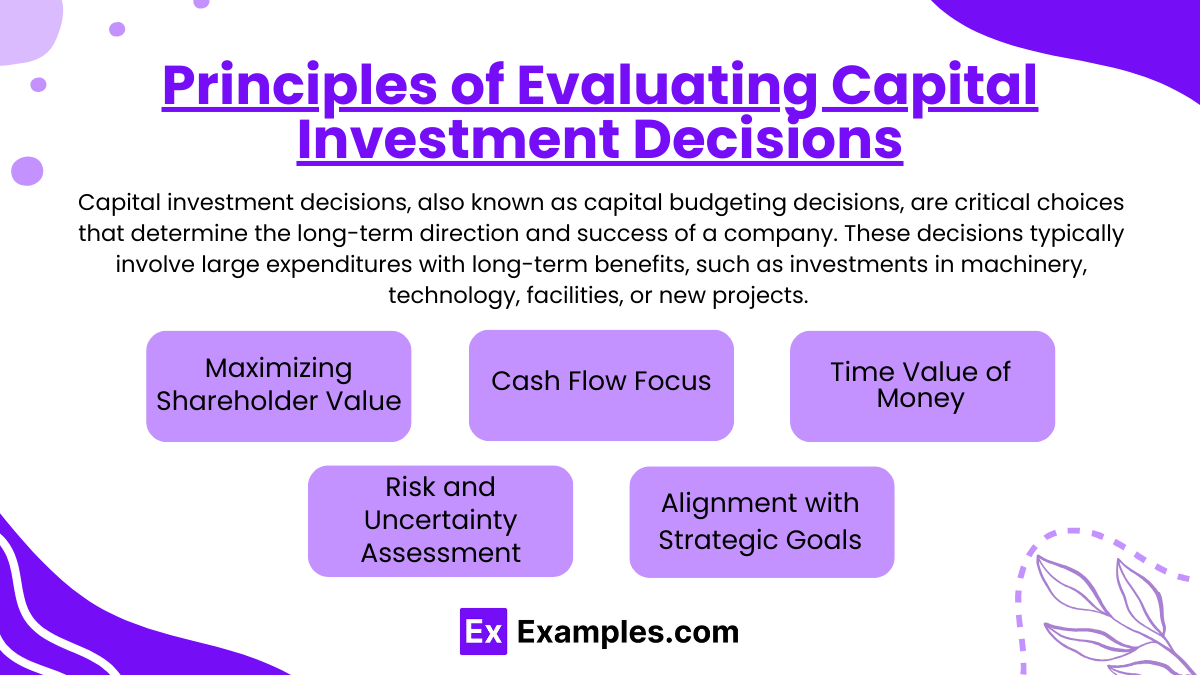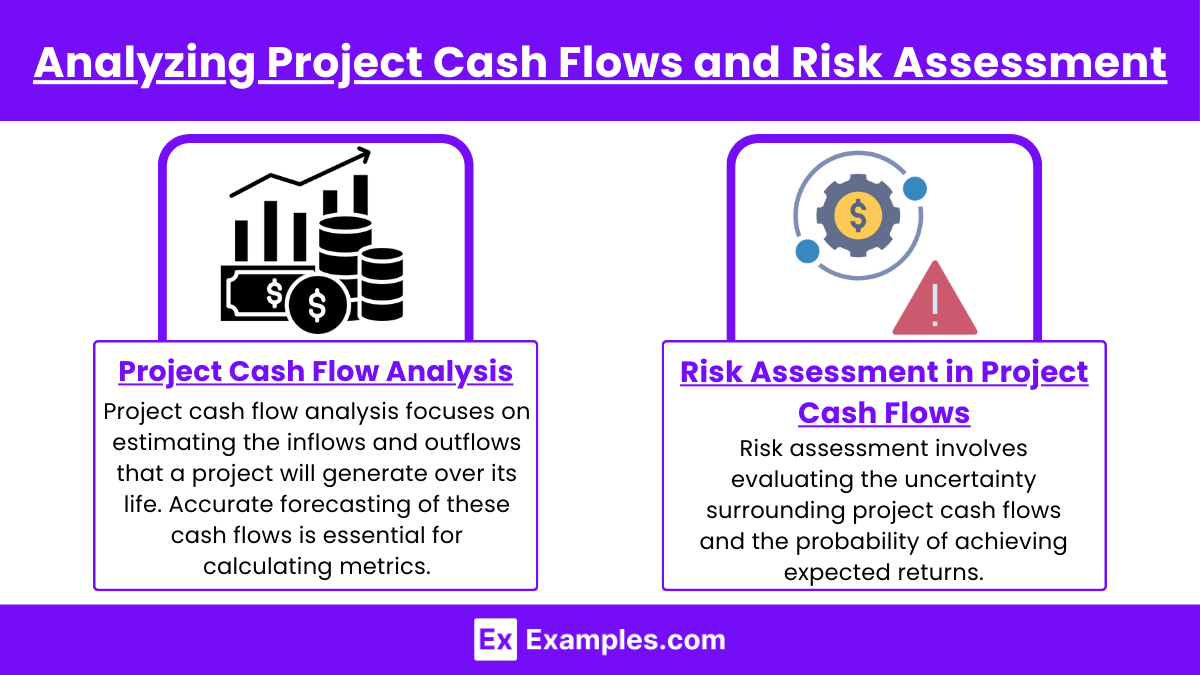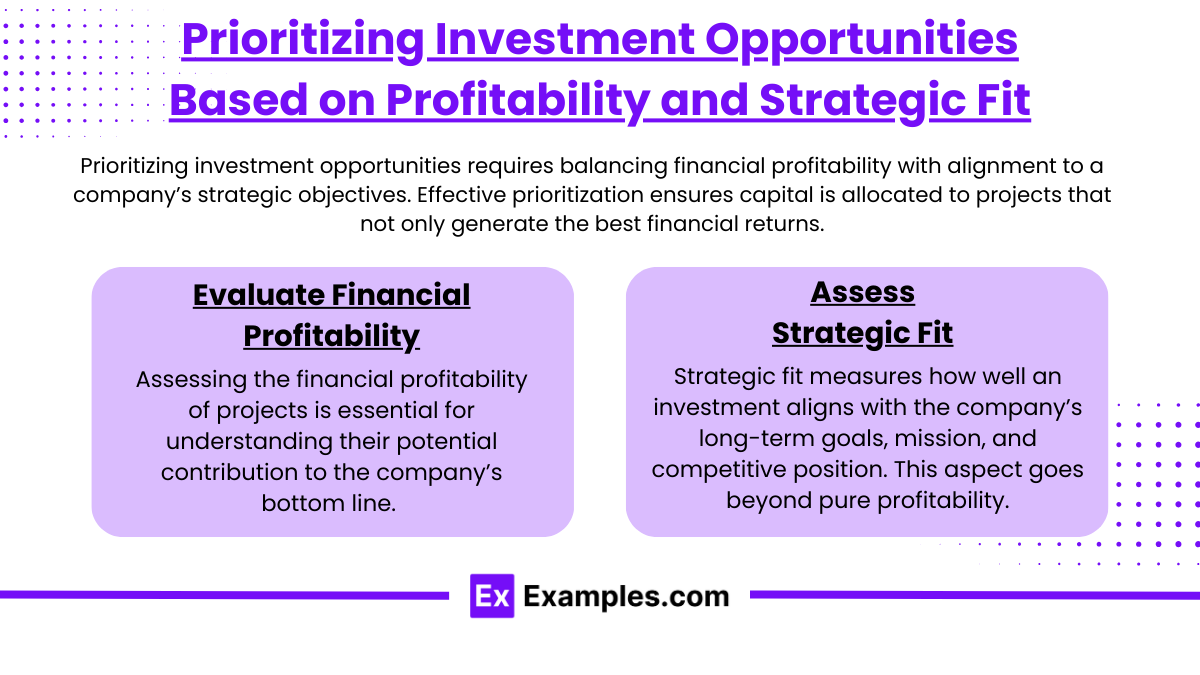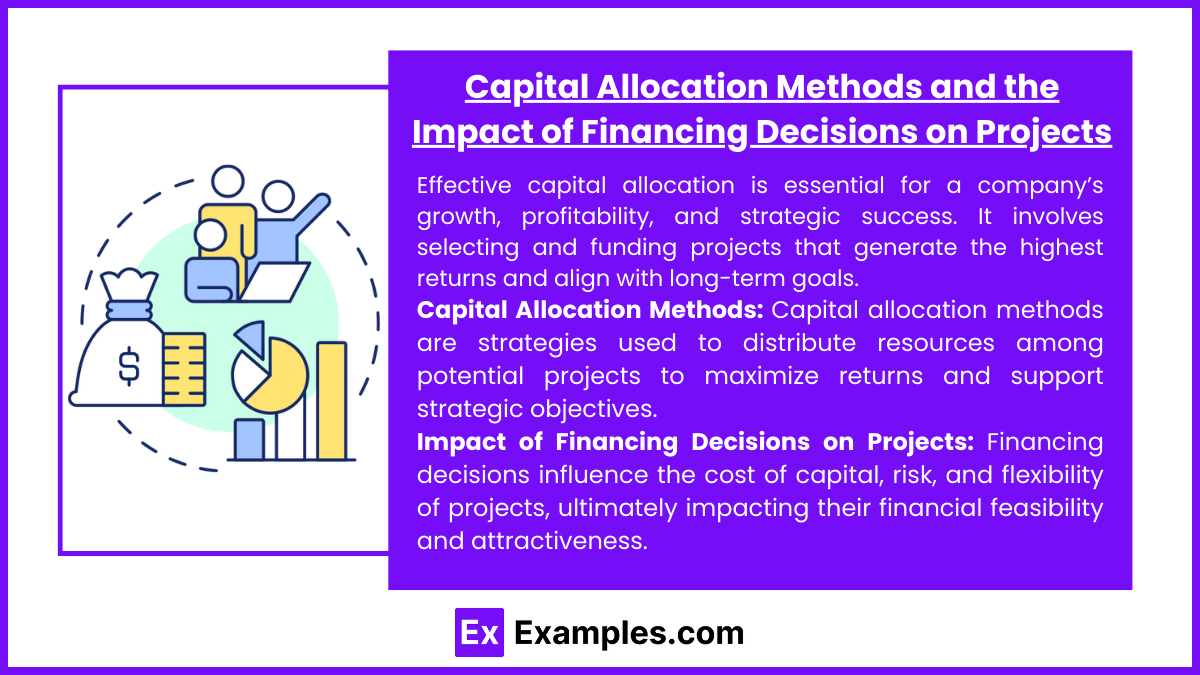Capital Investments and Capital Allocation are central to effective financial management, focusing on how organizations allocate resources to generate long-term value. This topic examines the decision-making processes involved in evaluating capital projects, including net present value (NPV), internal rate of return (IRR), and payback period. It also covers the methods for prioritizing investments, budgeting, and managing capital constraints. Mastery of these concepts is essential for assessing the potential returns and risks associated with various investments, ensuring that resources are optimally allocated to maximize shareholder value and drive organizational growth.
Learning Objectives
In studying “Capital Investments and Capital Allocation” for the CFA, you should learn to assess the principles and methodologies used in evaluating capital investment decisions, including the time value of money, net present value (NPV), and internal rate of return (IRR). Understand how to analyze project cash flows, risk assessment, and capital budgeting techniques to ensure effective capital allocation. Develop skills in prioritizing investment opportunities based on profitability and strategic fit within a company’s objectives. Evaluate different capital allocation methods, including capital rationing, and understand the impact of financing decisions on investment projects. Additionally, analyze the role of capital investments in value creation and their implications for shareholder wealth and long-term corporate strategy.
Principles of Evaluating Capital Investment Decisions

Capital investment decisions, also known as capital budgeting decisions, are critical choices that determine the long-term direction and success of a company. These decisions typically involve large expenditures with long-term benefits, such as investments in machinery, technology, facilities, or new projects. Effective evaluation of capital investments ensures that resources are allocated to projects that maximize shareholder value and align with strategic goals. Here are the key principles and methodologies used in evaluating capital investment decisions:
- Maximizing Shareholder Value
- The primary goal of capital investment decisions is to maximize shareholder value. Investments are evaluated based on their potential to generate future cash flows and contribute positively to the company’s overall value.
- Projects with positive net present value (NPV) and high internal rates of return (IRR) typically align with shareholder value maximization, as they promise returns that exceed the cost of capital.
- Cash Flow Focus
- Capital budgeting focuses on cash flows rather than accounting profits, as cash flows reflect actual liquidity and the capacity to reinvest or return value to shareholders.
- Cash inflows, outflows, and net cash flow over the life of a project are considered, including operating cash flows, tax implications, and changes in working capital.
- Time Value of Money
- The time value of money is a foundational principle, recognizing that cash flows received sooner are more valuable than those received later.
- Discounted cash flow (DCF) techniques are used to bring future cash flows to their present value, ensuring an accurate comparison of projects that deliver returns over varying timeframes.
- Risk and Uncertainty Assessment
- Investments carry risk, and capital budgeting principles account for potential variations in expected cash flows, project lifespan, and market conditions.
- Tools like sensitivity analysis, scenario analysis, and the weighted average cost of capital (WACC) are applied to assess and mitigate risks, ensuring that the company’s risk tolerance is maintained.
- Alignment with Strategic Goals
- Investment decisions should align with the company’s strategic goals, supporting its vision, mission, and long-term objectives.
- Projects are evaluated not only on financial metrics but also on their potential to strengthen the company’s competitive position, market reach, and operational capabilities.
Analyzing Project Cash Flows and Risk Assessment

Analyzing project cash flows and assessing risk are critical steps in evaluating capital investment decisions. Understanding projected cash flows and accounting for associated risks help decision-makers determine if a project aligns with the company’s financial goals and risk tolerance. This analysis involves forecasting cash flows, evaluating cash flow patterns, and applying risk assessment techniques to ensure accurate and reliable project evaluations. Here’s a breakdown of the key components in analyzing project cash flows and risk assessment:
1. Project Cash Flow Analysis
Project cash flow analysis focuses on estimating the inflows and outflows that a project will generate over its life. Accurate forecasting of these cash flows is essential for calculating metrics like net present value (NPV), internal rate of return (IRR), and payback period.
a. Identifying Relevant Cash Flows
- Initial Investment: This includes all upfront costs required to start the project, such as purchasing equipment, construction, and installation costs. These are considered outflows at the beginning of the project.
- Operating Cash Flows: These are cash inflows and outflows generated from the project’s regular operations. They include revenues, operating expenses, taxes, and changes in working capital.
- Terminal Cash Flows: The final cash inflows (or outflows) at the end of the project’s life, which may include salvage value from asset disposal and any related costs for project closure.
b. Calculating Free Cash Flow (FCF): Free cash flow represents the cash available after covering operating expenses and capital expenditures, often used in project valuation.
FCF = Operating Cash Flow−Capital Expenditures−Change in Net Working Capital
c. Timing of Cash Flows: The timing of cash flows is critical because earlier cash flows are more valuable due to the time value of money. Projects with faster returns (shorter payback periods) tend to be less risky, as they recover the investment quickly.
d. Incremental Cash Flows: Incremental cash flows are the additional cash flows that result directly from undertaking the project. These include any increases in revenues and expenses that wouldn’t occur without the project.
2. Risk Assessment in Project Cash Flows
Risk assessment involves evaluating the uncertainty surrounding project cash flows and the probability of achieving expected returns. Here are some common risk assessment techniques:
a. Sensitivity Analysis
Sensitivity analysis examines how changes in key variables (like sales volume, cost, or discount rate) affect project outcomes. It helps identify which variables have the greatest impact on project viability.
- Process:
- Adjust one variable at a time (e.g., sales volume or cost of materials) while keeping others constant.
- Observe how these changes impact metrics like NPV and IRR.
- Interpretation: Variables with the most significant impact indicate areas of high risk and suggest where management should focus on risk mitigation.
Example: A real estate developer may use sensitivity analysis to understand how changes in market rent affect the NPV of a property investment.
b. Scenario Analysis
Scenario analysis assesses the impact of different potential scenarios on project cash flows, such as best-case, worst-case, and base-case scenarios. This approach allows for a broader view of risks and potential outcomes.
- Process:
- Define a range of possible scenarios (e.g., optimistic, pessimistic, and expected).
- Estimate cash flows for each scenario and analyze the effect on NPV, IRR, or other performance measures.
- Interpretation: Scenario analysis provides a range of possible outcomes, allowing decision-makers to consider the best and worst possible cases for informed planning.
Example: An energy company might use scenario analysis to evaluate an oil exploration project, considering scenarios of high, medium, and low oil prices.
c. Break-Even Analysis
Break-even analysis determines the sales level or production volume at which a project’s cash inflows equal its cash outflows, leading to a net cash flow of zero. It highlights the minimum performance required for project viability.
- Process:
- Calculate the break-even point by dividing fixed costs by the contribution margin per unit.
- Determine if this break-even point is achievable based on market conditions and capacity.
- Interpretation: Projects with achievable break-even points are generally considered less risky.
Example: A software company developing a new application may calculate the break-even sales volume to cover development and marketing costs.
d. Risk-Adjusted Discount Rate
Applying a risk-adjusted discount rate involves using a higher discount rate for riskier projects, reflecting the uncertainty in cash flows. This approach adjusts the NPV calculation to account for the project’s specific risk level.
- Process:
- Set a discount rate based on the project’s risk profile, often above the company’s WACC for high-risk projects.
- Recalculate NPV using this higher rate.
- Interpretation: A project with a positive NPV at a risk-adjusted discount rate may offer returns that adequately compensate for its risk.
Example: A biotechnology firm evaluating a new drug development project may use a higher discount rate to reflect clinical and regulatory risks.
e. Monte Carlo Simulation
Monte Carlo simulation models the impact of multiple variables changing simultaneously, using probability distributions to generate a range of possible outcomes. This technique provides a probabilistic view of project results.
- Process:
- Define probability distributions for uncertain variables (e.g., sales growth, costs).
- Run numerous simulations to generate a distribution of possible outcomes for NPV, IRR, or other metrics.
- Interpretation: The simulation results indicate the probability of achieving various outcomes, helping companies understand the likelihood of success or failure.
Example: An investment bank may use Monte Carlo simulation to assess the range of potential returns for a complex infrastructure project.
f. Real Options Analysis
Real options analysis considers the flexibility that managers have to adapt to changes during the project’s life, such as delaying, expanding, or abandoning the project. This approach values the “options” embedded in investment decisions.
- Types of Options:
- Option to Delay: Wait for better conditions before investing.
- Option to Expand: Invest more if the project performs well.
- Option to Abandon: Exit the project if it becomes unprofitable.
- Interpretation: Real options provide a strategic view of the project, accounting for managerial flexibility to adapt to changes in market conditions.
Example: A mining company may use real options analysis to determine whether to expand operations if commodity prices rise or delay if they fall.
Prioritizing Investment Opportunities Based on Profitability and Strategic Fit

Prioritizing investment opportunities requires balancing financial profitability with alignment to a company’s strategic objectives. Effective prioritization ensures capital is allocated to projects that not only generate the best financial returns but also support the company’s mission, vision, and competitive positioning. Here’s how companies can prioritize investments based on profitability and strategic fit:
1. Evaluate Financial Profitability
Assessing the financial profitability of projects is essential for understanding their potential contribution to the company’s bottom line. Common financial metrics for evaluating profitability include:
a. Net Present Value (NPV)
- NPV measures the difference between the present value of a project’s cash inflows and outflows. Projects with a high NPV provide greater value to the company.
- Decision Rule: Rank projects by NPV, as those with higher NPV generally offer better profitability and should be prioritized, assuming they align with strategic objectives.
Example: A manufacturing company might calculate NPVs for multiple new product lines, selecting those with the highest NPVs for further consideration.
b. Internal Rate of Return (IRR)
- IRR is the discount rate that makes the NPV of a project zero. It represents the project’s expected rate of return.
- Decision Rule: Projects with IRR exceeding the cost of capital are typically profitable and can be prioritized if they meet strategic goals. For competing projects, those with the highest IRRs are generally preferred.
Example: A tech company evaluating product expansions might favor projects with higher IRR, as they signal strong returns relative to the company’s cost of capital.
c. Profitability Index (PI)
- PI calculates the ratio of the present value of cash inflows to the initial investment, showing value created per dollar invested.
- Decision Rule: Projects with a PI greater than 1 are generally profitable. In cases of limited capital, projects with the highest PI provide the best return on investment.
Example: In capital-constrained situations, a retail chain could prioritize expansion projects with the highest PIs, maximizing the return per dollar invested.
d. Payback Period and Discounted Payback Period
- Payback Period measures how quickly an investment’s initial outlay is recovered, providing insight into liquidity and risk.
- Decision Rule: Shorter payback periods indicate faster capital recovery and can be useful for prioritizing projects in high-risk environments.
Example: A small business might favor projects with shorter payback periods to ensure quicker cash flow recovery and reduced risk.
2. Assess Strategic Fit
Strategic fit measures how well an investment aligns with the company’s long-term goals, mission, and competitive position. This aspect goes beyond pure profitability to consider a project’s impact on the company’s overall strategy.
a. Alignment with Core Competencies
Projects that leverage the company’s strengths or core competencies are more likely to succeed and create value.
- Decision Rule: Prioritize projects that align with existing strengths, such as skilled personnel, technology, or brand reputation.
Example: A pharmaceutical company with expertise in oncology may prioritize cancer research projects, even if other therapeutic areas offer higher short-term returns.
b. Support for Long-Term Objectives
Projects should support the company’s long-term objectives, such as expanding market share, entering new regions, or enhancing sustainability.
- Decision Rule: Evaluate how each project contributes to long-term goals and rank projects that advance these objectives higher, even if immediate profitability is lower.
Example: A global retailer aiming for a larger digital presence may prioritize online platform improvements, despite lower initial returns than physical store expansions.
c. Competitive Advantage and Differentiation
Investments that enhance the company’s competitive position or offer unique advantages can drive sustainable growth.
- Decision Rule: Prioritize projects that create or strengthen competitive advantages, such as proprietary technology, cost leadership, or market exclusivity.
Example: A tech company investing in AI could prioritize projects that deepen AI capabilities, maintaining a competitive edge in data-driven services.
d. Risk Management and Diversification
Strategic fit includes assessing how projects impact the company’s risk profile. Projects that diversify revenue streams or reduce dependence on specific markets may be more strategically valuable.
- Decision Rule: Prioritize projects that reduce risk exposure or increase diversification, balancing high-return projects with those that stabilize cash flows.
Example: An oil company might invest in renewable energy projects to diversify its portfolio, reducing reliance on fossil fuels and aligning with environmental goals.
Capital Allocation Methods and the Impact of Financing Decisions on Projects

1. Capital Allocation Methods
Capital allocation methods are strategies used to distribute resources among potential projects to maximize returns and support strategic objectives.
a. Capital Budgeting Techniques
Capital budgeting techniques are used to evaluate the profitability and risk of potential projects, helping decision-makers choose the best investments. Key techniques include:
- Net Present Value (NPV): Measures the difference between a project’s cash inflows and outflows, discounted to their present value. Projects with positive NPV are preferred as they add value.
- Internal Rate of Return (IRR): Calculates the discount rate at which a project’s NPV is zero. Projects with IRR above the cost of capital are considered profitable.
- Profitability Index (PI): Compares the present value of cash inflows to the initial investment, showing value created per dollar invested. Projects with PI > 1 are generally attractive.
- Payback Period: Assesses how quickly the initial investment can be recovered from cash inflows, providing a liquidity measure, though it doesn’t account for the time value of money.
Example: A company may use NPV and IRR to evaluate several expansion opportunities, selecting the project with the highest NPV and IRR that aligns with its goals.
b. Capital Rationing
Capital rationing is used when a company has limited funds and must choose among competing projects. In such cases, prioritizing investments based on expected returns and strategic fit is critical.
- Soft Rationing: Occurs when a company imposes internal budget constraints to avoid overextension.
- Hard Rationing: Arises when external factors, like limited access to funding, restrict the company’s capital allocation.
Example: A company with limited funds might use a profitability index to rank projects, selecting those with the highest return per dollar invested within budget constraints.
c. Strategic Investment Decisions
These decisions are based on long-term goals and alignment with the company’s core strategy, even if the immediate financial returns aren’t high. Projects that build competitive advantage or expand market presence may be prioritized.
Example: A tech company might invest in R&D for innovation, even if short-term returns are low, to enhance its future product portfolio and market position.
d. Real Options Analysis
Real options provide flexibility by allowing management to make adjustments during the project’s life, such as expanding, delaying, or abandoning a project. This method values flexibility, which can be beneficial in uncertain markets.
Example: A pharmaceutical company investing in drug development might use real options to abandon the project if early trials aren’t promising, minimizing financial loss.
2. Impact of Financing Decisions on Projects
Financing decisions influence the cost of capital, risk, and flexibility of projects, ultimately impacting their financial feasibility and attractiveness. Here’s how different financing choices can affect capital allocation:
a. Debt Financing
Debt financing involves borrowing funds that the company must repay with interest. Common forms include loans, bonds, and credit lines.
- Impact on Cost of Capital: Debt can lower the overall cost of capital if the interest rate is lower than the cost of equity. However, excessive debt increases financial risk and may raise the company’s required return on future projects.
- Interest Tax Shield: Interest payments are tax-deductible, providing a tax shield that can make debt financing more cost-effective than equity.
- Fixed Obligations: Debt financing creates fixed obligations that require regular payments, impacting cash flow and potentially reducing flexibility in capital allocation.
Example: A manufacturing company may use debt financing to fund a factory expansion, benefiting from the tax shield on interest payments. However, high debt levels could limit funds for future investments.
b. Equity Financing
Equity financing involves raising capital by issuing shares, diluting ownership but not creating fixed obligations.
- Impact on Cost of Capital: Equity generally has a higher cost than debt due to the risk premium demanded by investors. However, it avoids fixed payment obligations, providing flexibility.
- Dilution of Ownership: Issuing new shares can dilute existing ownership, which may affect control and decision-making.
- Dividend Expectations: Equity investors may expect dividends or share price appreciation, which could impact cash flow and influence future capital allocation decisions.
Example: A high-growth tech startup might prefer equity financing to fund a new product, avoiding the cash flow pressure of debt repayments and preserving flexibility for future investments.
c. Hybrid Financing
Hybrid financing, such as convertible debt or preferred stock, combines elements of both debt and equity, providing unique advantages and trade-offs.
- Convertible Debt: This allows debt to convert to equity at a later date, typically at the discretion of the lender. It provides lower initial interest costs, with potential for equity conversion if the project succeeds.
- Preferred Stock: This offers fixed dividends but ranks above common stock in asset claims. It may provide a lower cost of capital than equity without voting rights dilution.
Example: A renewable energy firm might use convertible debt to fund a project. If the project is successful, investors could convert their debt into equity, sharing in the upside without adding to initial interest costs.
Examples
Example 1: Real Estate Development
A real estate development company allocates capital to acquire land and construct residential or commercial properties. This capital investment aims to generate rental income or sell the properties for a profit. By conducting market research and financial analysis, the company can assess potential returns on investment and make informed decisions about the best projects to pursue.
Example 2: Technology Upgrades
A manufacturing firm decides to invest in new machinery and automation technology to enhance production efficiency. This capital investment involves allocating funds to purchase state-of-the-art equipment that can reduce production costs and increase output. The decision is based on a cost-benefit analysis to ensure that the expected gains from increased efficiency justify the initial capital outlay.
Example 3: Research and Development (R&D)
A pharmaceutical company allocates a significant portion of its budget to research and development activities aimed at discovering new drugs. This capital investment is essential for innovation and staying competitive in the industry. The company must evaluate potential R&D projects for their feasibility and potential market impact, prioritizing those that align with its strategic goals.
Example 4: Expansion into New Markets
A consumer goods company plans to expand its operations into international markets. To facilitate this growth, it allocates capital to establish distribution centers and marketing initiatives in the new regions. This investment requires careful analysis of the target market’s demographics and consumer behavior to ensure that the capital is effectively utilized to generate revenue.
Example 5: Renewable Energy Projects
An energy company invests in renewable energy sources, such as solar or wind power, by allocating capital to build new facilities and infrastructure. This capital investment is driven by the increasing demand for sustainable energy solutions and regulatory incentives for green energy projects. The company assesses the long-term benefits of investing in renewable technologies, considering factors such as potential cost savings and environmental impact, to make informed capital allocation decisions.
Practice Questions
Question 1
What is the primary goal of capital allocation within a company?
A) To maximize short-term profits
B) To minimize operational costs
C) To optimize the use of resources for long-term growth
D) To increase employee satisfaction
Correct Answer: C) To optimize the use of resources for long-term growth.
Explanation: The primary goal of capital allocation is to ensure that a company uses its financial resources effectively to support its long-term strategic objectives and growth. This involves making decisions about where to invest capital—whether in new projects, technology, or market expansion—to maximize returns over time. While short-term profits and operational costs are important considerations, the overarching aim is to enhance the company’s sustainable growth and value creation.
Question 2
Which of the following is a common method for evaluating potential capital investments?
A) Employee surveys
B) Market share analysis
C) Net Present Value (NPV)
D) Competitor benchmarking
Correct Answer: C) Net Present Value (NPV).
Explanation: Net Present Value (NPV) is a widely used financial metric for evaluating the profitability of potential capital investments. It calculates the difference between the present value of cash inflows and outflows associated with an investment. A positive NPV indicates that the investment is expected to generate value over time, making it a crucial tool for capital budgeting decisions. While employee surveys and competitor benchmarking may inform broader strategic considerations, they are not direct methods for evaluating financial investments.
Question 3
When considering a capital investment, what is a key risk factor that a company must assess?
A) The company’s current market position
B) Potential changes in consumer preferences
C) The weather conditions for the upcoming year
D) Employee turnover rates
Correct Answer: B) Potential changes in consumer preferences.
Explanation: When assessing a capital investment, it is vital for a company to consider potential changes in consumer preferences, as these can significantly impact the success of the investment. Understanding market trends and consumer behavior helps to identify whether an investment will continue to meet demand over time. While other factors, such as market position and operational considerations, are important, shifts in consumer preferences can directly affect revenue and profitability, making it a critical risk factor in capital investment decisions.


